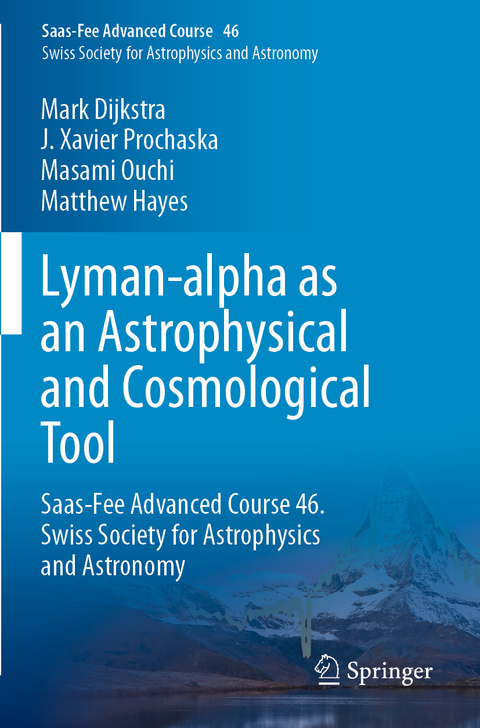
Lyman-alpha as an Astrophysical and Cosmological Tool
Springer Berlin (Verlag)
978-3-662-59625-8 (ISBN)
The hydrogen Lyman-alpha line is of utmost importance to many fields of astrophysics. This UV line being conveniently redshifted with distance to the visible and even near infrared wavelength ranges, it is observable from the ground, and provides the main observational window on the formation and evolution of high redshift galaxies. Absorbing systems that would otherwise go unnoticed are revealed through the Lyman-alpha forest, Lyman-limit, and damped Lyman-alpha systems, tracing the distribution of baryonic matter on large scales, and its chemical enrichment.
We are living an exciting epoch with the advent of new instruments and facilities, on board of satellites and on the ground. Wide field and very sensitive integral field spectrographs are becoming available on the ground, such as MUSE at the ESO VLT. The giant E-ELT and TMT telescopes will foster a quantum leap in sensitivity and both spatial and spectroscopic resolution, to the point of being able, perhaps, to measure directly the acceleration of the Hubble flow. In space, the JWST will open new possibilities to study the Lyman-alpha emission of primordial galaxies in the near infrared. As long as the Hubble Space Telescope will remain available, the UV-restframe properties of nearby galaxies will be accessible to our knowledge. Therefore, this Saas-Fee course appears very timely and should meet the interest of many young researchers.Editors:
Dr. Anne Verhamme is Senior Research Assistant at the Astronomical Department of the University of Geneva and Associated Researcher at CRAL, Lyon. She works on spectral diagnostics to study the escape of ionising photons and gas flows around galaxies, at the interface between simulations (coupling her radiation transfer code with radiation hydrodynamical simulations of galaxy formation) and observations (as a member of the MUSE consortium, and the LARS collaboration). She currently works on new indirect methods to probe the escape of ionising photons from the sources of cosmic reionisation, in particular from their Lyman-alpha properties (spectral shape and/or extend of their Lya halos), with a newly developed radiation transfer code, RASCAS, efficiently parallelised, and interfaced with state-of-the-art radiation hydrodynamic (RHD) simulations of galaxy formation. She obtained her PhD degree in Astronomy at the University of Geneva in 2008, working on Lyman-alpha radiation transfer effects in galaxies. In 2009, she was an SNF fellow at the Astrophysics department of Oxford University, and from 2010 to 2012, she was a Marie Curie fellow at CRAL, in Lyon, to compute the Lyman-alpha properties of virtual galaxies. Since Sept 2012, she returned to the University of Geneva (Excellence Fellow of the University of Geneva for 3 years, and "Marie Heim Vogtlin" SNF Fellow).
Dr. Pierre North is senior researcher and lecturer at the Laboratory of Astrophysics of the Ecole Polytechnique Fédérale de Lausanne (EPFL). He obtained his PhD degree in astronomy and astrophysics in 1984 at Geneva University. He worked on chemically peculiar stars, especially on the evolution of the angular momentum of magnetic Ap and Bp stars. He studied the rate and properties of binaries among this type of stars, and also determined the orbital and spectral properties of Ba dwarfs, to the discovery of which he contributed. He used astrometric and eclipsing binary systems to determine the distance of stellar systems like the Pleiades and the Small Magellanic Cloud, and to put constraints on stellar models. His research interests focus now on Lyman-alpha emitting nebulae around quasars, and on the chemical history of dwarf spheroidal galaxies and of the Milky Way outer halo through analysis of stellar spectra.
Dr. Hakim Atek is an assistant astronomer at Institut d'astrophysique de Paris (IAP) in France. He received his Master in astronomy and astrophysics from the University Pierre & Marie Curie (Paris VI). He obtained his Ph.D. in astrophysics in 2010 from the University Paris VI and the University of Geneva. He was a postdoctoral researcher at the California Institute of Technology (Caltech) for three years before moving to Switzerland for a second postdoctoral position at the Federal Institute of Technology in Lausanne (EPFL). During that period he spent one year as an associate research scientist at Yale University. He is primarily interested in the reionisation of the Universe and the formation and evolution of galaxies across cosmic time. He has a strong expertise in observational techniques with the Hubble Space Telescope and large ground-based facilities.
Prof. Sebastiano Cantalupo is an Assistant Professor of Cosmic Structure Formation at ETH Zurich. His research combines theoretical, numerical and observational approaches into a single program that is aimed at detecting and characterising with fluorescent Ly-alpha emission the diffuse intergalactic gas at high redshifts. This gas is believed to trace the cosmic web that drives the formation and growth of galaxies in the early Universe. Prof. Cantalupo completed his PhD in 2008 at ETH Zurich and subsequently held postdoctoral fellowship appointments at the Institute of Astronomy at the University of Cambridge and at the Department of Astronomy and Astrophysics at the University of CalifPhysics of Lya Radiative Transfer.- HI Absorption in the Intergalactic Medium.- Observations of Lya Emitters at High Redshift.- Lyman alpha Emission and Absorption in Local Galaxies.- Index.
| Erscheinungsdatum | 05.03.2022 |
|---|---|
| Reihe/Serie | Saas-Fee Advanced Course |
| Zusatzinfo | XVII, 403 p. 314 illus., 193 illus. in color. |
| Verlagsort | Berlin |
| Sprache | englisch |
| Maße | 155 x 235 mm |
| Gewicht | 646 g |
| Themenwelt | Naturwissenschaften ► Physik / Astronomie ► Astronomie / Astrophysik |
| Naturwissenschaften ► Physik / Astronomie ► Relativitätstheorie | |
| Schlagworte | Damped Lyman-alpha Systems • epoch of reionisation • Galaxy Evolution • Galaxy Formation • galaxy populations • High-Redshift Galaxies • Lyman-alpha forest • resonance line transfer |
| ISBN-10 | 3-662-59625-3 / 3662596253 |
| ISBN-13 | 978-3-662-59625-8 / 9783662596258 |
| Zustand | Neuware |
| Haben Sie eine Frage zum Produkt? |
aus dem Bereich


